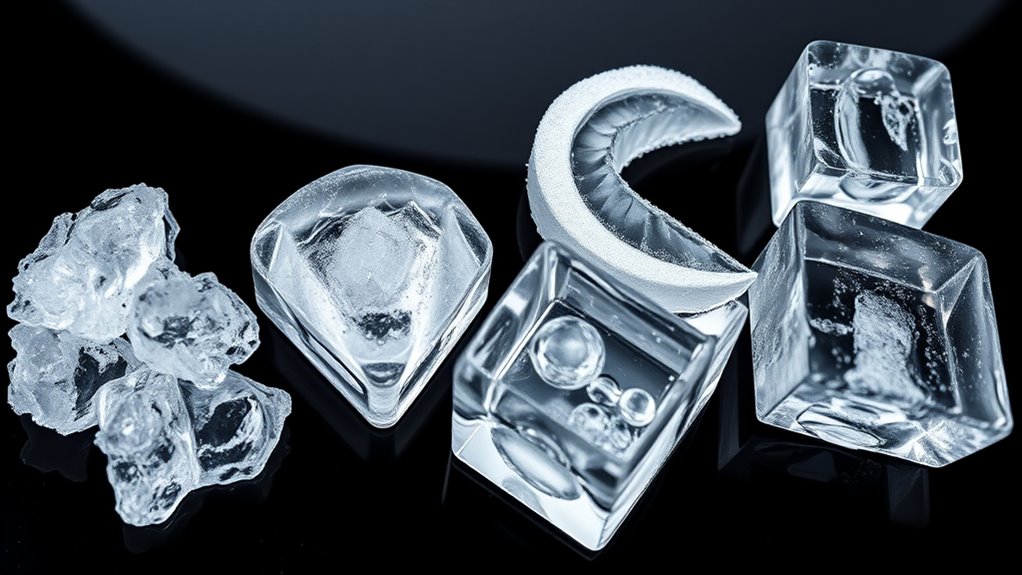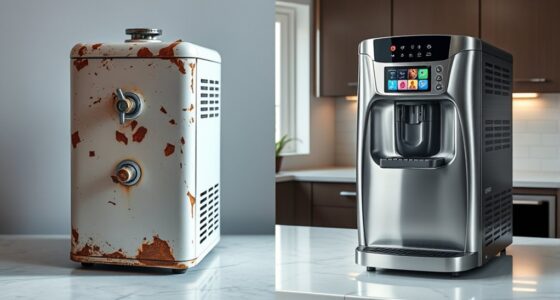Nugget ice is small, soft, and chewable, perfect for beverages like sodas or cocktails, and it melts slowly. Crescent ice has a curved, half-moon shape that looks appealing and cools drinks efficiently. Clear and gourmet ice offer transparency and dense, large pieces that reduce melting and enhance presentation. Each type serves different purposes, whether for quick cooling, aesthetic appeal, or prolonged flavor. Keep exploring to discover how each can elevate your beverage experience.
Key Takeaways
- Nugget ice is small, chewable, and porous, ideal for beverages and healthcare due to slow melting.
- Crescent ice has a curved, half-moon shape that enhances visual appeal and slows melting.
- Clear and gourmet ice are dense, transparent, and large, offering aesthetic appeal and longer-lasting chill.
- Different ice types serve specific purposes: nugget for texture, crescent for visual and cooling efficiency, and clear/gourmet for elegance.
- Water quality and proper manufacturing techniques improve ice clarity, safety, and overall presentation.
Nugget Ice: Characteristics and Uses
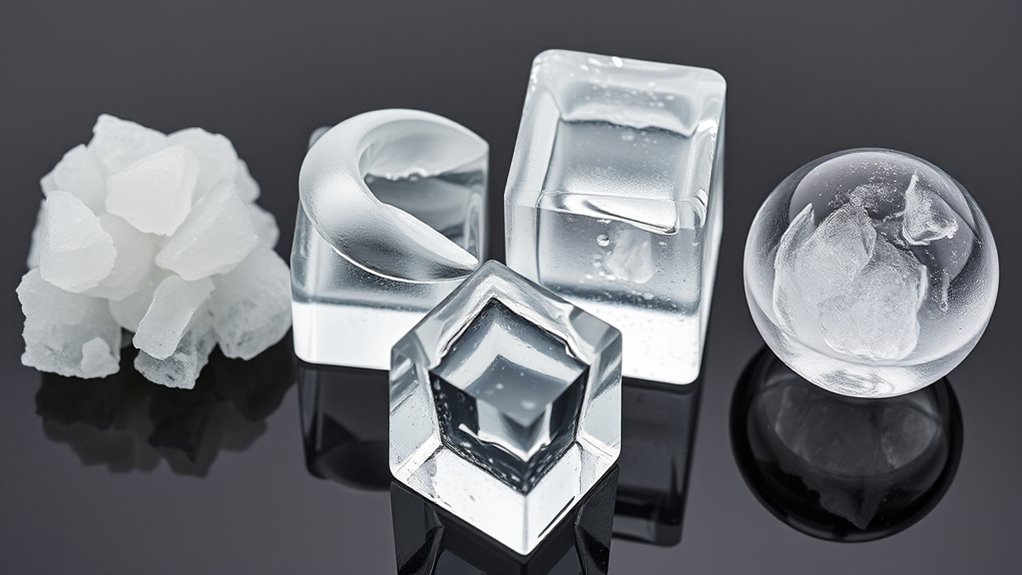
Nugget ice stands out because of its small, soft, and chewable pieces that resemble tiny hailstones or ice pellets. Typically about 1 cm long, these cylindrical or pellet-shaped bits have a porous, gentle texture that’s easy to bite into without sharp edges. With a water content of around 15–25%, they melt slowly, making them ideal for keeping drinks cold longer without quickly watering them down. Nugget ice forms through a process where water freezes into thin flakes on a chilled surface, then a rotating auger breaks and compresses these flakes into uniform, chewable nuggets. Thanks to its unique texture and slow melting, nugget ice is highly favored for beverages like sodas, cocktails, and iced coffee, delivering a satisfying crunch while maintaining the drink’s flavor and temperature. Its popularity has increased in modern commercial settings, especially in establishments emphasizing water efficiency and customer satisfaction.
Crescent Ice: Shape, Formation, and Appeal
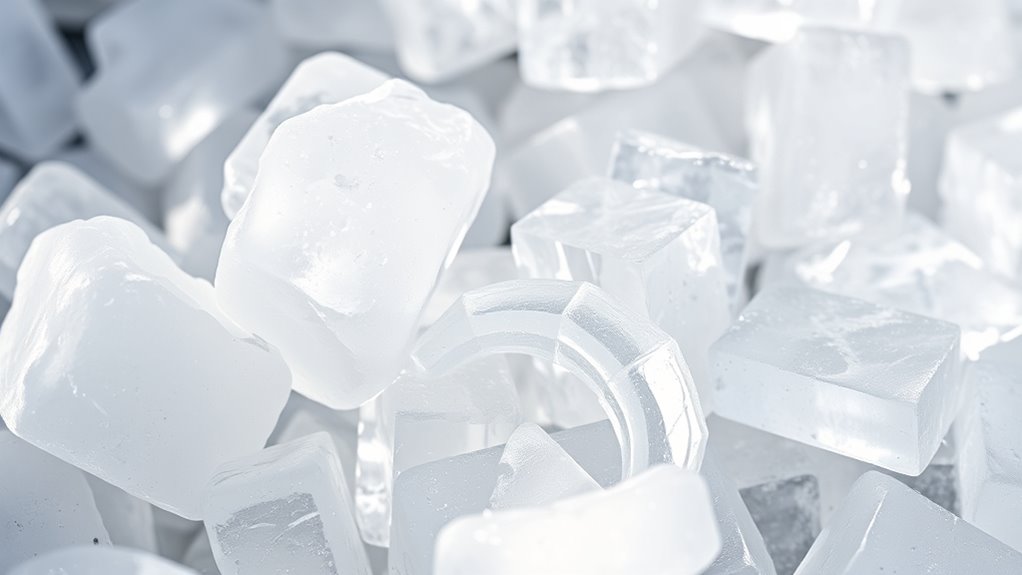
Ever wondered why crescent ice is a popular choice in many beverages? Its distinctive curved, half-moon shape offers several benefits. Imagine:
- The broad crescent form, resembling a natural ice formation, adds visual appeal.
- Its shape maximizes surface area, providing efficient cooling.
- Small to medium size makes it perfect for drinks and ice bags.
- The curved design slows melting, reducing dilution and preserving flavor.
Crescent ice forms when water flows over a chilled mold, freezing along the edges into the familiar shape. Modern machines automate this process, ensuring consistent production. The curved structure fits snugly in glasses, enhancing both presentation and cooling. Its slower melt rate keeps drinks flavorful longer, making it a favorite in bars and restaurants. Additionally, sustainable manufacturing practices are increasingly adopted to produce crescent ice more efficiently and environmentally friendly. This combination of form and function makes crescent ice a practical and stylish choice.
Clear and Gourmet Ice: Quality and Aesthetic Benefits
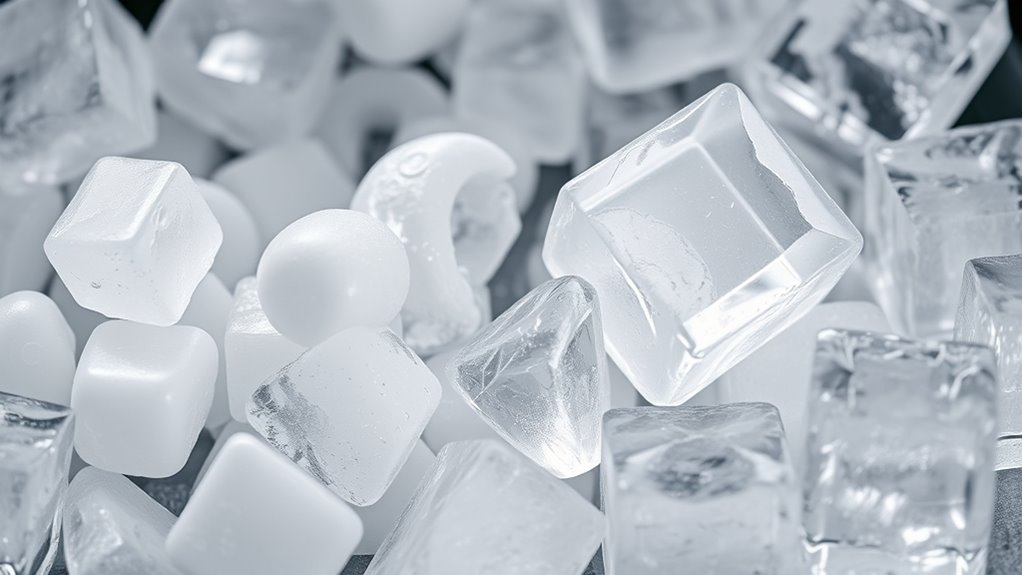
Clear and gourmet ice elevate the presentation and quality of your beverages by combining visual appeal with functional performance. Clear ice’s transparency showcases your drink’s color and adds elegance, while its density slows melting, maintaining flavor longer. Gourmet ice features large, dense cubes or spheres that preserve temperature and reduce dilution, making drinks more refined. Both types resist cracking and cloudiness, ensuring a pristine look and cleaner taste. Their clarity and durability enhance upscale settings, reflecting luxury and sophistication. Additionally, their thermal properties contribute to an improved drinking experience by maintaining optimal temperatures for extended periods. Understanding water quality and proper filtration can further enhance the clarity and longevity of your ice, ensuring consistent quality every time.
Comparing Different Ice Types: Features and Applications
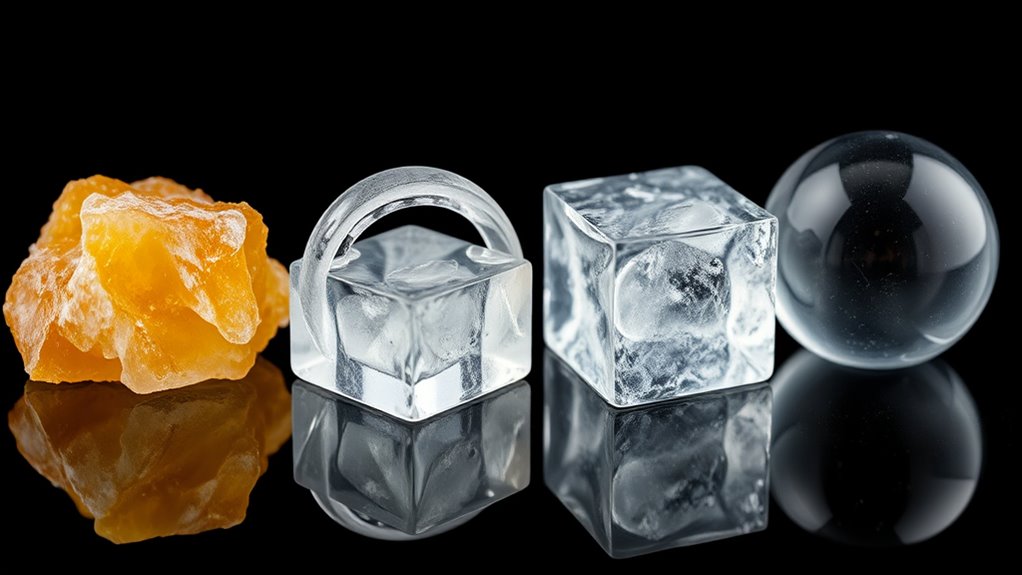
Different ice types serve specific purposes based on their features and applications. Nugget ice, with its soft, chewable texture and slow melt rate, is perfect for cocktails, soft drinks, and healthcare settings. Crescent ice, with its half-moon shape and dense structure, reduces splashing, maximizes volume, and is widely used in bars and restaurants. Crushed ice, composed of small fragments, cools drinks rapidly, making it ideal for frozen cocktails or slushies. Full- and half-dice ice cubes balance melt rate and chill time, suited for fountain drinks or immediate consumption. Each type offers unique benefits, whether for prolonged chilling, quick cooling, or presentation, helping you choose the right ice for your specific needs. Additionally, understanding the filtration technology used in ice machines can improve the overall safety and quality of the ice you enjoy, which is a key aspect of software quality assurance in manufacturing processes.
Frequently Asked Questions
How Does Water Quality Affect Different Ice Types?
Water quality directly impacts the clarity, taste, and durability of ice. If your water has high mineral content, you’ll notice cloudier, less appealing ice, especially affecting clear and gourmet types. Organic impurities and dissolved gases cause cloudiness and weaken the ice structure. Poor pH or chemical imbalances can lead to faster machine wear and inconsistent ice. To guarantee high-quality ice, treat and filter your water properly before freezing.
Which Ice Type Melts the Slowest in Beverages?
You’ll find that clear ice melts the slowest in beverages. Its large, dense, and solid structure reduces surface area exposed to the liquid, which slows down melting. Because it’s free of air bubbles and impurities, it maintains its form longer, preserving your drink’s flavor and presentation. If you want to keep your beverage colder longer without diluting it quickly, clear ice is your best choice.
Can You Reuse or Refreeze Melted Ice Effectively?
You shouldn’t reuse or refreeze melted ice effectively because it can pose health risks and compromise quality. When melted, contaminants can grow, especially if left at unsafe temperatures, and refreezing creates irregular, porous ice with trapped air bubbles. For safety and quality, it’s better to dispose of melted ice and use fresh ice, especially in food service. If necessary, sterilize and filter melted ice before refreezing in small amounts.
What Factors Influence the Clarity of Gourmet Ice?
You can make your gourmet ice clearer by using purified water, preferably distilled or filtered, to reduce impurities and dissolved gases. Slow, directional freezing helps air bubbles and impurities escape, resulting in transparent ice. Keep the water at a slightly warmer, consistent temperature before freezing, and avoid agitation during the process. These steps help produce beautifully clear, high-quality gourmet ice that enhances your drinks’ presentation.
Are There Health Differences Between Various Ice Types?
You might wonder if different ice types impact health. Generally, there’s no significant difference in health risks solely based on ice form—whether nugget, crescent, clear, or gourmet. However, the way you consume them matters; for example, contaminated or improperly handled ice can pose bacterial risks. Nutritional content isn’t particularly different, but be mindful of added ingredients or contaminants that could affect your health. Proper hygiene and moderation are key.
Conclusion
Now that you know the different ice types, you’ll appreciate their unique qualities. Did you know that nugget ice is preferred in 70% of restaurants for its chewability? Whether you want the quick chill of crescent, the clarity of gourmet, or the versatility of nuggets, choosing the right ice enhances your experience. So next time, pick the perfect type to suit your drink or event—your guests will notice the difference!
